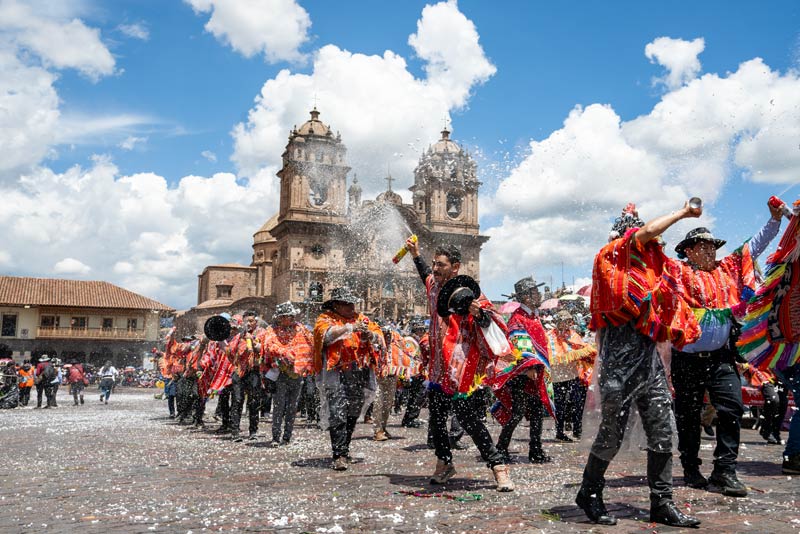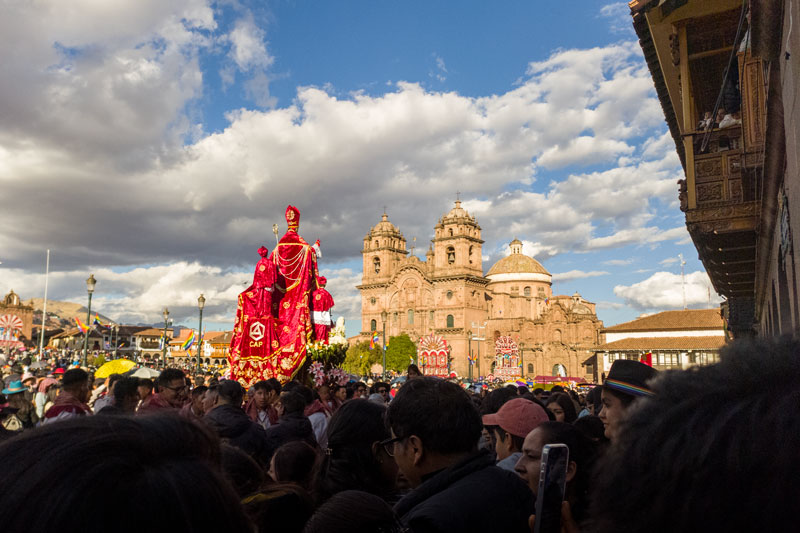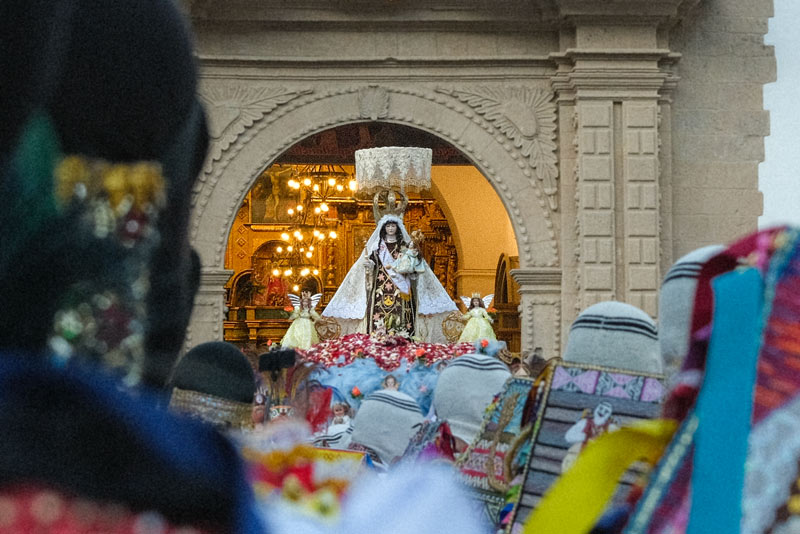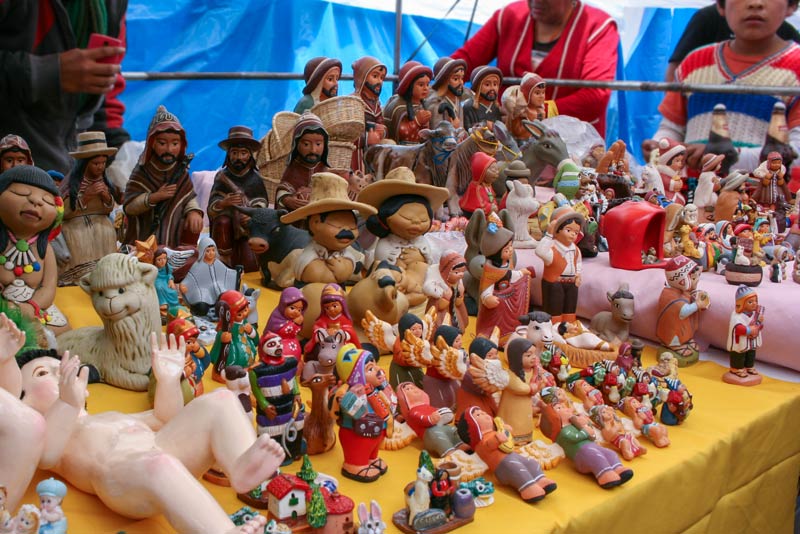Calendar of festivals and traditions in Cusco
The history and traditions preserved in Cusco make it one of the most important cultural epicenters in the world. Throughout the year, there’s a reason to fill the city with joy and color, imbuing your trip to this magical place with beauty. That’s why today we’ll detail the most important festivals, so you don’t miss any of them while you’re visiting.
- Andean Carnivals
- Easter week
- Lord of Qoylluriti
- Corpus Christi
- Inti Raymi
- Virgin of Carmen
- National Holidays
- Pachamama Day
- Day of the Living – Day of the Dead
- Santurantikuy
- New Year
- Tips and recommendations
- Frequently Asked Questions
Andean Carnivals
The Cusco Carnival is a festival that involves the entire community in colorful activities ranging from dances to games accompanied by water and foam. The epicenter is the Plaza de Armas, where, starting on Sunday morning, the main day, people gather to enjoy parades of traditional dances accompanied by music that vibrates the city center.
During this day of Carnival in Cusco, the city is also filled with water games, in which everyone seems to participate, so if you’re out walking around the city on this day, it’s best to be careful because you might get splashed.
Carnival in Cusco also has its pre-event festivities, such as the Day of the Comprades (celebrated in honor of men), the Day of the Comadres (celebrated in honor of women), and the popular Kacharpari, which is the “finale” of Carnival. Remember that you can also experience this festivity in any town in Cusco, ensuring your experience of this traditional celebration.
Central Day: Movable, although it is always the Sunday before Ash Wednesday. In 2026, Carnival will be on February 15.
Easter week
Days filled with religious and traditional activities await us during Holy Week. It’s an ideal time to visit Cusco, as we embark on cultural holidays where the city is filled with color and great fervor. The festivities begin on Palm Sunday, where the city’s churches are the epicenter. Then comes the most important day for Cusco residents, Holy Monday, when the Lord of the Earthquakes holds his popular procession through the city center beginning in the early afternoon.
Another very important day is Holy Thursday, when twelve traditional dishes are prepared in commemoration of the twelve apostles of Jesus Christ. It’s an ideal day to sample the full range of Cusco cuisine, including soups, broths, sweets, desserts, and many other main dishes. During Good Friday, it’s customary to visit seven churches, offering a much more artistic and religious atmosphere. The Holy Week celebration closes on Easter Sunday, when the churches once again take center stage.
Central Days: Movable, although it always begins on the Sunday after the first full moon after the vernal equinox. For 2026, it will be from March 29 to April 5.
Lord of Qoylluriti
The celebration of the Lord of Qoylluriti is the religious expression that brings together the largest number of people outside of Cusco. During the day’s pilgrimage, more than ten thousand devotees participate, traveling to the Sinankara sanctuary, very close to the Ausangate snow-capped mountain, approximately 4,700 meters above sea level and near temperatures that drop below 0°C.
For the pilgrimage, devotees from all over Peru gather in groups called “nations,” arriving from different locations with flags, distinctive attire, and dances. Also prominent are the so-called “pabluchas,” who retain a mystical aspect and are popularly known as soldiers of the Lord, as they carry out the most important liturgical missions.
Remember that you can only reach the Sanctuary of the Lord of Qoylluriti by walking approximately 9 kilometers , although there are also horses that will allow you to make the journey more easily.
Central Day: Movable, although it begins the week before Corpus Christi. By 2026, it will be between May 31 and June 3.
Corpus Christi
Religious festivals are always present in the city of Cusco, as reflected in Corpus Christi, a festivity in which fifteen saints and virgins are carried on floats through the main square and their respective city neighborhoods. The parade of Catholic images during Corpus Christi has Andean origins, given that in Inca times, the “mallquis,” the mummies of emperors, were venerated and paraded through the city in commemoration of their legacy and importance.
Today, Corpus Christi revives the syncretism of traditions in a day filled with fervor. Although eight days later, the popular octave also takes place, where the celebration continues with light parades and commemorations in honor of the Virgins and saints. Corpus Christi is also an opportunity to discover the more authentic side of the local cuisine, as you will find many fairs in honor of Chiri Uchu, a staple food during this festival.
Central Day: Movable, although it is always the Thursday after Trinity Sunday. In 2026, Corpus Christi will be celebrated on June 4.
Inti Raymi
The most important festival in the Cusco calendar is Inti Raymi, the Inca festival honoring the sun, which also takes place on the anniversary of the city of Cusco. It’s a day filled with nostalgia and emotion, where this historic celebration is commemorated in three main locations in the city: the Qoricancha temple, the main square, and the Sacsayhuamán esplanade.
Through offerings and rituals, the people remember the importance of the sun, the earth, and nature for harmonious coexistence, just as the Incas did. The city is already a day of celebration, with activities throughout the month of June filling the city with joy. During this month, we can also see parades, dances, allegories, musical evenings, fireworks, a wide variety of cuisine, and a wealth of tradition.
Central Day: June 24.
Book your Inti Raymi experience
If you want to experience the full Inti Raymi festival, you can book your tickets at any time of the year, although we recommend doing so at least a month in advance to ensure your participation. The Festival of the Sun is a celebration filled with dance, music, history, and colors that will allow you to relive the traditions of one of the world’s most important cultures and discover their way of relating to nature in reciprocity.
Virgin of Carmen
The festival of the Virgin of Carmen in Paucartambo is one of Peru’s most significant religious celebrations. “La Mamacha Carmen,” as the Virgin is popularly known, is venerated in a celebration filled with traditional dances that fill the small magical town of Paucartambo with joy and devotion.
The festival lasts four days, and during each day you’ll learn how Andean and Catholic traditions merge in religious, civic, and festive activities, demonstrating the uniqueness and beauty of this celebration. The town of Paucartambo is not far away—just two hours from Cusco—making for an unforgettable experience. Plus, if you take a little extra time, you can experience the enchanting sunrise of the three golden crosses near Paucartambo.
The festival of the Virgin of Carmen is also celebrated in other traditional towns such as Pisac and Huarocondo in Cusco.
Central days: July 15-18.
National Holidays
Peru’s patriotic days fill Cusco with many civic and festive activities , such as the military parade, the parade of institutions and schools, gastronomic festivals, and dance performances from the region’s thirteen provinces, along with plenty of music. The main square is the epicenter, as with all important activities in Cusco, where we can see how the people of Cusco pay homage to their homeland.
The national holidays in Cusco also take place during its best weather , which is why many people choose to travel to this magnificent territory, visiting places like Machu Picchu, the Sacred Valley, the Rainbow Mountain or simply taking a tour of the city on its most colorful days, surrounded by unforgettable landscapes.
Central day: July 28.
Pachamama Day
For Andean culture, “Pachamama” is a deity to whom constant tribute is paid, as she is the earth itself . However, during Pachamama Raymi (the Mother Earth Festival), an entire day is dedicated to her devotion and homage. Pachamama is conceived as a god capable of bringing abundance and fertility to the earth. She is also considered present in all of nature, which requires care and protection, receiving reciprocal treatment for her bounties.
For this reason, many celebrations are held in her honor, such as the Day of Resurrection, where people place their offerings on a blanket, which is later buried or burned in a ceremonial ritual. It’s a day where the land is not worked, and thanks are given only for bringing prosperity to the community that celebrates it. Mother Earth Day is celebrated throughout the Andean world, but in Cusco, it is characterized by the devotion of each of the communities that comprise it.
Central day: August 1st.
Day of the Living – Day of the Dead
These are two traditional days in Cusco that seek to commemorate life and death by appreciating the present and remembering the deceased. First, there is All Souls’ Day, which, while not featuring many cultural activities, offers a moment of reflection for oneself and loved ones, appreciating and embracing the fact that we still have them. This day is also often called All Saints’ Day.
The Day of the Dead is celebrated the following day, when the Cusco community visits their deceased loved ones in cemeteries or sacred fields. Each niche is filled with flowers and food that their loved ones enjoyed. One of the main characteristics of the Day of the Living and the Day of the Dead in Cusco is the famous wawa bread , which refers to a child and is a symbol of renewal. Horse bread is also found , symbolizing the path and journey toward renewal. These breads are usually given as gifts between loved ones as a demonstration of affection.
Main dates: November 1 – 2
Santurantikuy
Santurantikuy is the largest traditional art fair in Peru, bringing together sculptors, artisans, painters, and artists from all fields. The epicenter is usually the main square, where nearly 500 stands display traditional art. Plants and accessories for the creation of nativity scenes, which represent the birthplace of Christ, are also often sold.
Children, who represent the newborn Christ, are the main characters in the Santurantikuy , for whom you can buy everything from clothing to accessories, so you can fill the representative Nativity scene with color. Many of the artisans who present their art spend the entire year waiting for this date to sell, so the works you’ll find are some of the most beautiful and original in all of Peru.
The origin of this festival dates back to when farmers and artisans gathered in the main square to sell and exchange their products. Today, its authenticity is maintained, but the variety of products is much greater, combining Andean and contemporary fusions.
Central dates: December 21-24.
New Year
Celebrating the New Year is an impressive festivity anywhere, but doing so in Cusco can be one of the best experiences of your life. New Year’s is celebrated in the Plaza de Armas, a place where people of all cultures gather to welcome a new year full of possibilities and surprises.
The magical celebration includes fireworks and free concerts, where you’ll meet many people and perform traditional rituals to seek good luck. The festivities last all night , though you can start looking for the best place to welcome the new year from early on. Plus, since the Plaza de Armas is one of the most beautiful spots, you’ll find the perfect photo opportunity to capture the moment.
Central date: December 31.
| Cusco’s most important cultural events | ||
|---|---|---|
| Party | Date for 2026 | Brief description |
| Andean Carnivals | February 15 | Festive celebration with dances, parades, and water and foam games. |
| Easter week | March 29 to April 5 | Procession of the Lord of the Tremors, tasting of the traditional twelve dishes and visit to the seven churches. |
| Lord of Qoylluriti | May 31st and June 3rd | Pilgrimage, a blend of Catholic faith and worship of the Ausangate snow-capped mountain. |
| Corpus Christi | June 4th | Procession of images of Cusco’s most venerated saints and virgins, an opportunity to try Chiri Uchu. |
| Inti Raymi | June 24 | Staging of the largest Inca festival in honor of the sun in Qoricancha, the main square, and Sacsayhuamán. |
| Virgin of Carmen (Paucartambo) | July 15-18 | A syncretistic festival with dance, music, and lots of color in a traditional magical town. |
| National Holidays | July 28 | National celebration of Peru with parades, civic events, and cultural festivals. |
| Pachamama Day | August 1st | Ritual payments to Mother Earth with offerings, paying tribute and gratitude. |
| Day of the Living – Day of the Dead | November 1 and 2 | Tradition of visiting cemeteries, bringing offerings and eating bread in the shape of children and horses (t’antawawas). |
| Santurantikuy | December 24th | Great art fair in the Plaza de Armas. |
| New Year | December 31st | Contemporary party in the Plaza de Armas to welcome the new year. |
Tips and recommendations
If you’d like to venture to Cusco to experience one of these magical traditional festivals, we’ll offer some tips and recommendations that will make your experience much more immersive and informed, so you don’t miss a single detail and make it one of your best experiences.
- During your first few days in Cusco, remember to engage in light activities to avoid altitude sickness. Traveling to the Sacred Valley can help because it’s at a lower altitude.
- Maintain a constant attitude of gratitude toward the Earth for everything you’ve experienced on your journey. This will enrich your experience and make you feel more present.
- If you are in Cusco during the rainy season (November – March), be prepared at all times with waterproof clothing or a rain poncho, as the weather can be rainy at any time.
- When you visit Cusco during the dry season (April through October), you’ll find more stable and clear weather, although there are usually more visitors.
- The best months to visit Cusco are June and July, when you’ll find many cultural activities such as Inti Raymi, Corpus Christi, Fiestas Patrias, the Virgen del Carmen festival, and the Señor de Qoylluriti festival.
- Visiting Cusco is magical throughout the year, as the landscapes are constantly changing and you’ll always see a new angle of its geography.
- If you want to visit Macha Picchu, remember to book your tickets at least two months in advance for major routes.
- Cusco boasts some of the best cuisine in all of Peru, so your visit in July should be accompanied by tasting typical dishes that you can often only find during this time.
- Always remember to preserve and reciprocate with nature, just as they do in Andean culture. It’s a way of living in harmony, conscious of its importance and value.
- With Boletomachupicchu, you can book your ideal experience in Cusco year-round. Ask our advisors about all the options available to make your trip unforgettable.
Frequently Asked Questions
1) What is the best time to visit Cusco if I want to see its main festivals?
If you’re planning to experience the most traditional and colorful festivals, we recommend traveling between June and July. This period marks the celebration of iconic festivals such as Qoylluriti, Corpus Christi, Inti Raymi, the Virgin of Carmen, and Fiestas Patrias.
2) What traditions can’t I miss if I visit Cusco in February?
You should definitely participate in the Andean Carnival. It’s a joyful festival filled with music, dance, and water games. If you visit the Plaza de Armas, you’re likely to get soaked.
3) What is Holy Week like in Cusco?
Holy Week in Cusco combines religious fervor with Andean culture. The most anticipated moment is the procession of the Lord of the Earthquakes on Holy Monday. It is also traditional to try the twelve typical dishes of Holy Thursday.
4) What do I need to know if I want to participate in the pilgrimage to the Lord of Qoylluriti?
It’s important that you’re physically and mentally prepared because the hike to the Sinakara sanctuary reaches an altitude of over 4,700 meters above sea level. The experience is intense and spiritual, connecting deeply with Andean traditions.
5) What is Corpus Christi like in Cusco?
During Corpus Christi, you’ll see fifteen saints and virgins parade through the streets of Cusco in an event steeped in history. It’s also the perfect excuse to try the famous Chiri Uchu, a signature dish of this holiday.
6) How can I best enjoy Inti Raymi?
It’s best to purchase your tickets in advance from us for the shows in Sacsayhuamán and Qoricancha. You can also watch part of the ritual for free in Qoricancha and the Plaza de Armas.
7) Is it advisable to travel to Paucartambo for the Virgin of Carmen festival?
Yes, absolutely. Paucartambo is a very special place, with dances, traditions, and music. The trip from Cusco is only two hours, and the experience is unforgettable. If you can, take the opportunity to see the sunrise at Tres Cruces de Oro.
8) How is Pachamama Day celebrated in Cusco?
On August 1st, rituals of reverence are performed to thank the earth, thanking nature for its fertility and harvests. It is a very spiritual and reflective day.
9) What is the New Year’s celebration like in Cusco?
New Year’s in Cusco is celebrated in the streets, especially in the Plaza de Armas, with fireworks, concerts, and rituals to attract good luck, alongside people from many cultures.
10) What typical dishes should I try if I travel during these holidays?
Depending on the holiday, try Chiri Uchu during Corpus Christi, the twelve traditional dishes during Holy Week, and the traditional breads during the Day of the Dead. Cusco is a culinary paradise, so any time of year is a great time to enjoy it.
Advice from people who have been there
 By: Cristian M.
By: Cristian M.“Take a tour“
“Doing the City Tour in Cusco was amazing. I visited historical sites such as Qoricancha and Sacsayhuaman, and learned a lot about the Inca culture. The scenery, the history and the energy of the place made me connect deeply with the essence of this magical city.“
By Ticket Machu Picchu – Last updated, July 22, 2025




